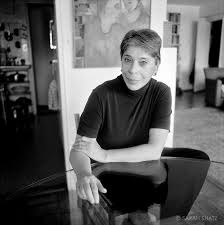Anne Sexton. Image via poetryfoundation.org.
Consider these three presentations of the opening lines of Anne Sexton’s poem “Moon Song.”
Version #1
Moon Song
I am alive at night
I am dead in the morning—
an old vessel who used up her oil,
bleak and pale-boned.
No miracle. No dazzle
I'm out of repair,
but you are tall in your battle dress
and I must arrange for your journey.
I was always a virgin,
old and pitted.
Before the world was, I was,
. . .
Version #2
Version #3
image via theatlantic.com.
Note how with each step, the presentation takes on more personality and arouses interest.
The presentation of version #1, rendered through flawless on-screen lettering, feels almost without personality. Such perfection suggests something nameless, at best institutional, “The Internet.”
Note, by contrast, the personality already detectable in version #2, the typewritten version. Here, the unevenness of the ink saturation, the typewriter's clumsy kerning of the letters (the lack of adjustments of space between individual letters) and the slight skew of the horizontal and vertical lines instantly lend the poem a clearer sense of human authorship, even as this same shift in presentation also makes the poem more difficult to read.
That tradeoff is most pronounced in version #3, which is in Sexton's own handwriting. Whether or not one would want to read an entire book of handwritten poems, Christopher Alexander’s principle of Roughness can be seen here in the fact that of these examples the third is both the roughest in appearance and by far the most alive.
Thank you for reading.































